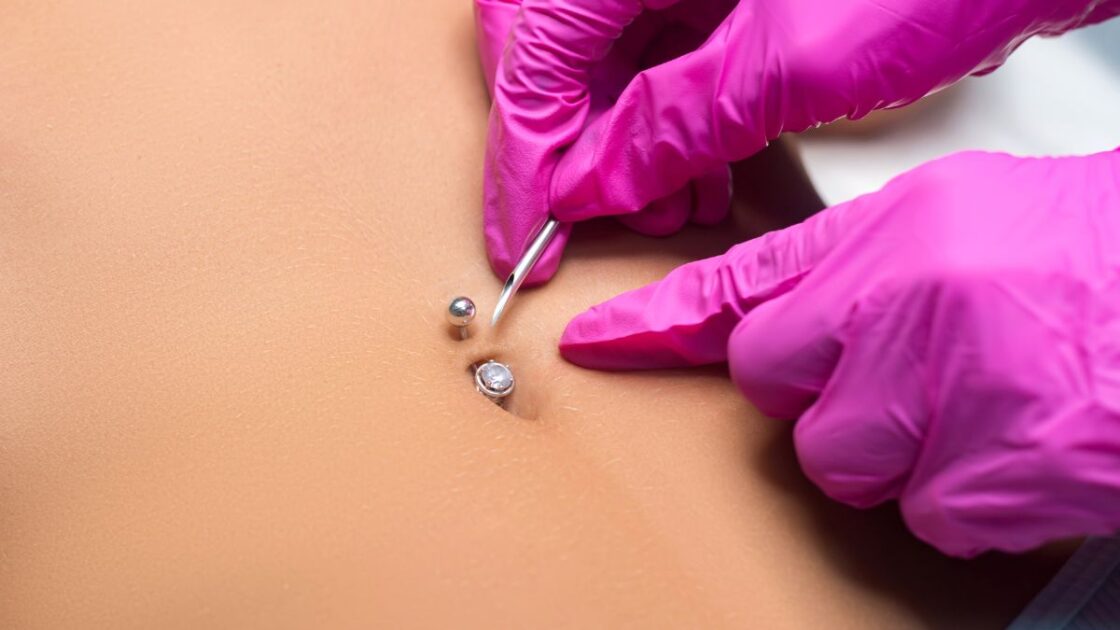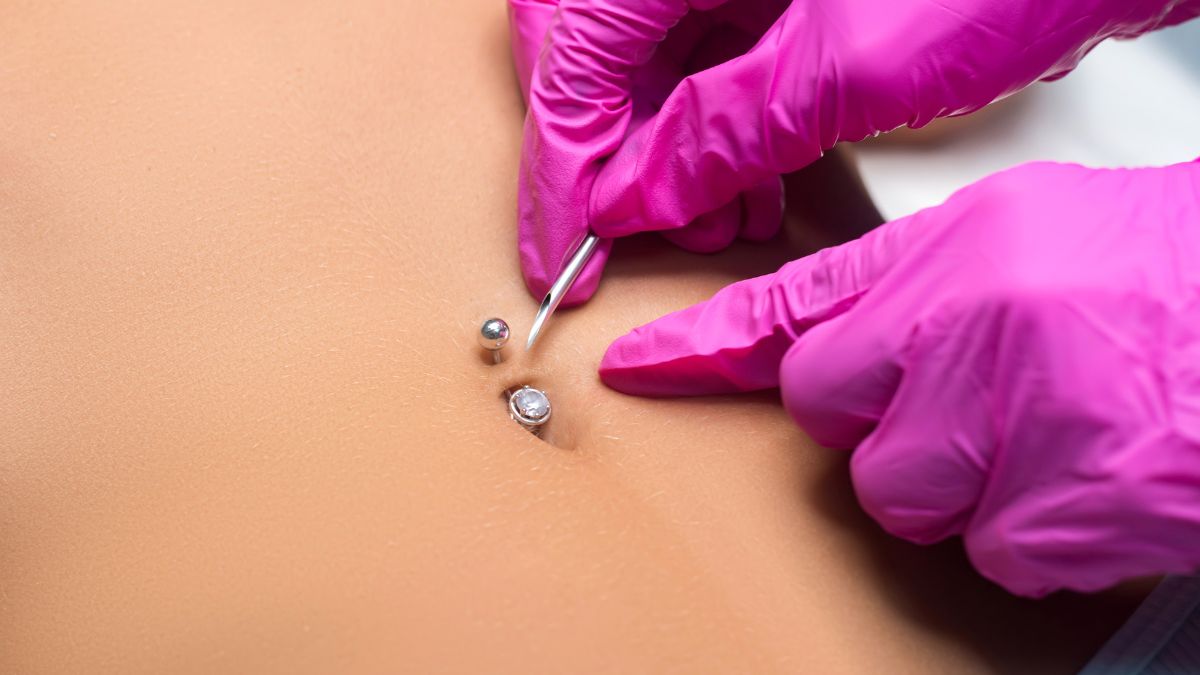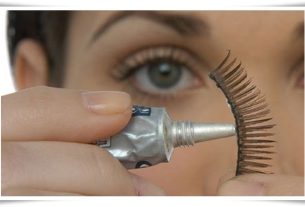Belly button piercing is a popular form of body modification that involves piercing the belly button to insert decorative jewelry. It’s a personal style choice that can add a touch of style and individuality to your look. However, before deciding to get a navel piercing, it is important to be aware of the different aspects related to this type of piercing. In this article, we will discuss everything you need to know about belly button piercing, from the piercing process to post-piercing care.
See Also: Ear Piercing: All the Necessary Information and Essential Care
1. What is a navel piercing?

A navel piercing is a piercing made in the tissue around the navel to insert jewelry. Generally, a navel piercing is made up of two parts: an external visible part and an internal part that is inside the body. There are several styles of jewelry available for belly button piercings, such as straight bars, hoops, or dangling jewelry.
See Also: Tattoo to hide dark circles: what it is, how it is done and risks
2. Drilling process
The belly button piercing process should be carried out by an experienced and qualified professional, such as a professional piercer. Before performing the piercing, the piercer will clean and disinfect the area around the belly button to reduce the risk of infection. Then, a sterile needle will be used to make the piercing, and the chosen jewelry will be inserted.
It is important to remember that piercing the navel can cause some discomfort and sensitivity during and after the procedure. It is normal to experience some level of pain and swelling in the first few days after piercing.
See Also: 7 things you need to know before getting a tattoo
3. Post-piercing care
After belly button piercing, it is essential to properly care for the area to avoid complications and promote proper healing. Here are some tips for post-belly button piercing care:
3.1 Keep the area clean
Gently wash the pierced area with warm water and mild soap twice a day. Avoid using irritating products, such as alcohol or hydrogen peroxide, as they can impair healing.
3.2 Avoid touching or moving the jewelry
Avoid touching the jewelry or touching the pierced area unnecessarily. This can introduce bacteria and increase the risk of infection. If you need to adjust or rotate your jewelry, be sure to wash your hands thoroughly before doing so.
3.3 Wear comfortable clothes
During the healing process, it is recommended to wear loose, comfortable clothing that does not put pressure on or irritate the pierced area.
3.4 Avoid swimming pools and hot tubs
Avoid swimming in chlorinated pools or hot tubs during the healing process, as these environments may contain bacteria that increase the risk of infection.
3.5 Be careful when practicing sports or physical activities
Avoid activities that can put excessive pressure or cause trauma to the pierced area, such as contact sports or intense exercise.
See Also: 7 most common mistakes made when getting a tattoo
4. Healing time
Healing time for a belly button piercing can vary from person to person. In general, it takes 6 to 12 months for the belly button to heal completely. During this period, it is important to continue following post-piercing care and avoid changing the jewelry before healing is complete.
See Also: Cuticle tattoo: decorated nail trend
5. Possible complications
Although most belly button piercings heal without problems, there are some complications that can arise. Some of the possible complications include:
- Infection: If the pierced area is not kept clean and hygienic, infection may occur. Signs of infection include redness, swelling, pain, and pus discharge. If you suspect an infection, it is important to seek immediate medical care.
- Rejection or migration: In some cases, the body may reject the piercing jewelry and push it out. This may result in the jewelry migrating out of the belly button. If you notice the jewelry moving or coming off, consult a professional for evaluation.
- Keloid: Some people may develop keloids, which are raised, thick scars, after piercing their navel. Keloids can be treated with options such as corticosteroid creams, compression or surgical removal.
Conclusion
A belly button piercing is a personal style choice that can add a touch of individuality to your look. However, it is important to consider all aspects related to this type of piercing before deciding to get it. Be sure to choose an experienced professional piercer, follow post-piercing care appropriately, and be aware of possible complications. With proper care and attention, you can enjoy a belly button piercing safely.
FAQs (Frequently Asked Questions)
1. How long does it take for a belly button piercing to heal? Healing time for a belly button piercing can vary, but it generally takes 6 to 12 months to heal completely.
2. Is it normal to feel pain after getting your belly button pierced? Yes, it is normal to experience some level of pain and sensitivity in the first few days after getting your belly button pierced.
3. Can I change my belly button piercing jewelry before it has completely healed? It is not recommended to change piercing jewelry before healing is complete, as this may interfere with the healing process and increase the risk of complications.
4. Can navel piercing cause infection? Yes, if the pierced area is not kept clean and hygienic, infection can occur. It is important to follow post-piercing care and be aware of signs of infection.
5. What are the signs of infection in a belly button piercing? Signs of infection in a belly button piercing include redness, swelling, pain, and pus discharge. If you suspect an infection, it is important to seek immediate medical care.
6. Is it possible to remove a belly button piercing if I don’t like it anymore? Yes, it is possible to remove a belly button piercing. However, it is important to follow the guidance of a professional to ensure removal is done properly and safely.
7. What are the most common jewelry for a belly button piercing? The most common jewelry for a belly button piercing includes straight barbells, hoops, and dangling jewelry. The choice of jewelry depends on personal taste and desired style.
8. Does a navel piercing leave a permanent scar? Although belly button piercing healing can vary from person to person, it is possible that there will be a small residual scar after the jewelry is removed. The appearance of the scar may depend on several factors, such as the piercing technique and post-piercing care.
9. Is it necessary to undergo any type of medical examination before getting a navel piercing? It is generally not necessary to undergo specific medical tests before getting a belly button piercing. However, it is always recommended to consult a professional to assess your overall health and discuss any concerns before the procedure.
10. What are the most common complications of a belly button piercing? Some of the most common complications include infection, jewelry rejection or migration, and keloid formation. It is important to be aware of these possible complications and seek professional help if necessary.
Follow our publications on Google News.

Sign up for our newsletter and stay up to date with exclusive news
that can transform your routine!
Warning: Undefined array key "title" in /home/storelat/public_html/wp-content/plugins/link-whisper-premium/templates/frontend/related-posts.php on line 12
Warning: Undefined array key "title_tag" in /home/storelat/public_html/wp-content/plugins/link-whisper-premium/templates/frontend/related-posts.php on line 13




